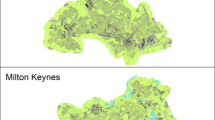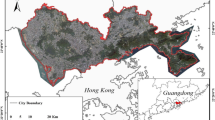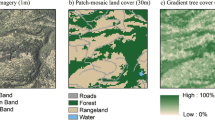Abstract
Landscape ecology links landscape pattern to ecological function. Achieving this goal hinges on accurate depiction and quantification of pattern, which is frequently done by visually interpreting remotely sensed imagery. Therefore, understanding both the accuracy of that interpretation and what influences its accuracy is crucial. In addition, imagery is pixel-based but landscape pattern exists, more realistically, as irregularly shaped patches. Patches may contain only one feature type such as trees, but, in some landscapes, patches may contain several different types of features such as trees and buildings. Using a patch-based approach, this paper investigates two types of variables—whole-patch and within-patch—that are hypothesized to influence the accuracy of visually estimating the cover of features within patches. A highly accurate reference map, obtained from object-based classification, was used to evaluate the accuracy of visual estimates of cover within patches. The effects of the variables on the accuracy of these estimates were tested using logistic regressions and multimodel inferential procedures. Though all variables significantly affected the accuracy, the within-patch configuration of features is the most significant factor. In general, errors of cover estimates are more likely to occur when patches are smaller or have more complex shapes, and features within a patch are (1) more diverse; (2) more fragmented; (3) more complex in shape; and (4) physically less connected. These results provide an important first step towards a quantitative, spatially explicit model for predicting error of cover estimates and determining under what circumstances estimation error is most likely to occur.



Similar content being viewed by others
References
Agresti A (1996) An introduction to categorical data analysis. Wiley, New York
Akaike H (1973) Information theory and an extension of the maximum likelihood principle. In: Second international symposium on information theory. Akademiai Kaidó, Budapest
Allard A, Nilsson B, Pramborg K, Ståhl G, Sundquist S (2003) Manual for aerial photo interpretation in the national inventory of landscapes in Sweden NILS. Department of Forest Resource Management and Geomatics, Umeå
Antrop M, Van Eetvelde V (2000) Holistic aspects of suburban landscapes: visual image interpretation and landscape metrics. Landsc Urban Plan 50:43–58
Blaschke T (2010) Object based image analysis for remote sensing. ISPRS J Photogramm Remote Sens 65(1):2–16
Burnham KP, Anderson DR (2002) Model selection and multimodel inference: a practical information-theoretic approach. Springer, New York
Cadenasso ML, Pickett STA, Schwarz K (2007) Spatial heterogeneity in urban ecosystems: reconceptualizing land cover and a framework for classification. Front Ecol Environ 5:80–88
Cherrill A, McClean C (1995) An investigation of uncertainty in field habitat mapping and the implications for detecting land cover change. Landscape Ecol 10(1):5–21
Clehmann CER, Prior LD, Bowman DMJS (2009) Decadal dynamics of tree cover in an Australian tropical savanna. Austral Ecol 34:601–612
Congalton RG, Mead RA (1983) A quantitative method to test for consistency and correctness in photointerpretation. Photogramm Eng Remote Sens 49(1):69–74
Ellis EC, Wang H (2006) Estimating area errors for fine-scale feature-based ecological mapping. Int J Remote Sens 27(21):4731–4749
Ellis EC, Wang H, Xiao H, Peng K, Liu XP, Li SC, Ouyang H, Cheng X, Yang LZ (2006) Measuring long-term ecological changes in densely populated landscapes using current and historical high resolution imagery. Remote Sens Environ 100(4):457–473
Fensham RJ, Fairfax RJ (2002) Aerial photography for assessing vegetation change: a review of applications and the relevance of findings for Australian vegetation history. Aust J Bot 50:415–429
Fensham RJ, Fairfax RJ (2003) Assessing woody vegetation cover change in north-west Australian savanna using aerial photography. Int J Wildl Fire 12(4):359–367
Fensham RJ, Fairfax RJ (2007) Effect of photoscale, interpreter bias and land type on woody crown-cover estimates from aerial photography. Aust J Bot 55:457–463
Fensham RJ, Fairfax RJ, Holman JE, Whitehead PJ (2002) Quantitative assessment of vegetation structural attributes from aerial photography. Int J Remote Sens 23(11):2293–2317
Gill SE, Handley JF, Ennos AR, Pauleit S, Theuray N, Lindley SJ (2008) Characterising the urban environment of UK cities and towns: a template for landscape planning. Landsc Urban Plan 87:210–222
Groom G, Mucher CA, Ihse M, Wrbka T (2006) Remote sensing in landscape ecology: experiences and perspectives in a European context. Landscape Ecol 21:391–408
Gustafson EJ (1998) Quantifying landscape spatial pattern: what is the state of the art? Ecosystems 1:143–156
Heiskanen J, Nilsson B, Mäki AH, Allard A, Moen J, Holm S, Sundquist S, Olsson H (2008) Aerial photo interpretation for change detection of treeline ecotones in the Swedish mountains. Sveriges lantbruksuniversitet, Umeå
Hosmer D, Lemeshow S (2000) Applied logistic regression, 2nd edn. Wiley, New York
Iverson L (2007) Adequate data of known accuracy are critical to advancing the field of landscape ecology. In: Wu J, Hobbs R (eds) Key topics in landscape ecology. Cambridge University Press, Cambridge, pp 11–38
Li H, Wu J (2007) Landscape pattern analysis: key issues and challenges. In: Wu J, Hobbs R (eds) Key topics in landscape ecology. Cambridge University Press, Cambridge, pp 39–61
Lillesand TM, Kiefer RW (2004) Remote sensing and image interpretation. Wiley, New York
McGarigal K, Cushman SA, Neel MC, Ene E (2002) FRAGSTATS: spatial pattern analysis program for categorical maps. Computer software program. University of Massachusetts, Amherst. http://www.umass.edu/landeco/research/fragstats/fragstats.html. Accessed 6 April 2012
Nagelkerke NJD (1991) A note on a general definition of the coefficient of determination. Biometrika 78(3):691–692
Paine DP, Kiser JD (2003) Aerial photography and image interpretation, 2nd edn. Wiley, Hoboken
Richards JA, Jia X (2006) Remote sensing digital image analysis. Springer, New York
Schumaker NH (1996) Using landscape indices to predict habitat connectivity. Ecology 77:1210–1225
Shao G, Wu J (2008) On the accuracy of landscape pattern analysis using remote sensing data. Landscape Ecol 23:505–511
Shao G, Liu D, Zhao G (2001) Relationships of image classification accuracy and variation of landscape statistics. Can J Remote Sens 27(1):33–43
Smith JH, Wickham JD, Stehman SV, Yang LM (2002) Impacts of patch size and land-cover heterogeneity on thematic image classification accuracy. Photogramm Eng Remote Sens 68:65–70
Smith JH, Stehman SV, Wickham JD, Yang LM (2003) Effects of landscape characteristics on land-cover class accuracy. Remote Sens Environ 84:342–349
Ståhl G, Allard A, Esseen P, Glimskär A, Ringvall A, Svensson J, Sundquist S, Christensen P, Torell Å, Högström M, Lagerqvist K, Marklund L, Nilsson B, Inghe O (2011) National Inventory of Landscapes in Sweden (NILS)—scope, design, and experiences from establishing a multiscale biodiversity monitoring system. Environ Monit Assess 173:579–595
Turner MG (2005) Landscape ecology: what is the state of the science? Annu Rev Ecol Evolution Syst 36:319–344
Turner MG, Gardner RH, O’Neill RV (2001) Landscape ecology in theory and practice: pattern and process. Springer, New York
Wagenmakers EJ, Farrell S (2004) AIC model selection using Akaike weights. Psychon Bull Rev 11(1):192–196
Wu J, Hobbs R (2002) Key issues and research priorities in landscape ecology. Landscape Ecol 17:355–365
Zhou W, Troy A (2008) An object-oriented approach for analyzing and characterizing urban landscape at the parcel level. Int J Remote Sens 29(11):3119–3135
Zhou W, Huang G, Troy A, Cadenasso ML (2009) Object-based land cover classification of shaded areas in high spatial resolution imagery of urban areas: a comparison study. Remote Sens Environ 113(8):1769–1777
Zhou W, Schwarz K, Cadenasso ML (2010) Mapping urban landscape heterogeneity: agreement between visual interpretation and digital classification approaches. Landscape Ecol 25(1):53–67
Acknowledgments
This research was funded by the National Science Foundation LTER program (grant DEB 042376), and CAREER program (DEB-0844778).
Author information
Authors and Affiliations
Corresponding author
Rights and permissions
About this article
Cite this article
Zhou, W., Cadenasso, M.L. Effects of patch characteristics and within patch heterogeneity on the accuracy of urban land cover estimates from visual interpretation. Landscape Ecol 27, 1291–1305 (2012). https://doi.org/10.1007/s10980-012-9780-x
Received:
Accepted:
Published:
Issue Date:
DOI: https://doi.org/10.1007/s10980-012-9780-x




